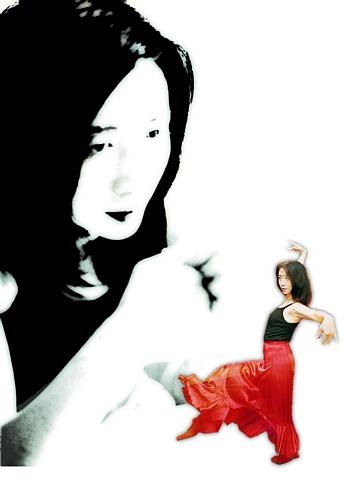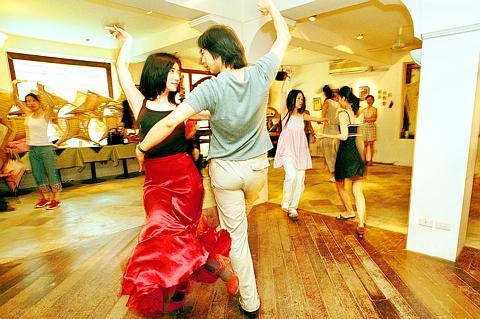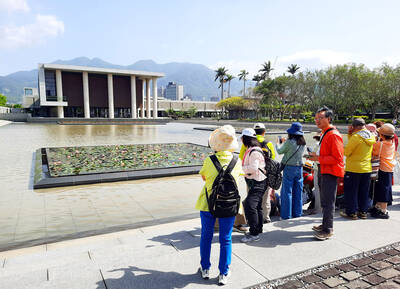Six years ago on a rainy day, painter Lee Shin (
"Each of your works is like a dance," he said to her.
"He told me he was a Flamenco dancer from an amateur troupe," she recalls.

PHOTO: CHEN CHENG-CHANG, TAIPEI TIMES
"That is a very profound dance," he said, exploring the gallery with her.
"I later realized he was the only dancer in the 'troupe'," she says. "But by the time I realized it, I'd already fell in love with the dance - the beauty and passion, the joy and sadness of Gypsy's lives."
Lee Shin and Lin Keng (

PHOTO: CHEN CHENG-CHANG, TAIPEI TIMESN
"This dance troupe was a result of playing too much and playing too far with my life," Lee says, jokingly.
A life left behind
Before "the dancer" Lee Shin, or even the painter Lee Shin, there was Lee Shin the dentist, employed at a public hospital for more than a decade. She was a career woman with an affluent income, the wife of a successful businessman and the mom of a 10-year-old girl. She was well-off and secure.
But security was never what she'd been looking for. "I wore white robes with mask, facing my patients everyday. But I felt out of touch with people and life," she says. "Of course you can find senses of achievement in curing people's illnesses, but ... teeth problems are, essentially, never solvable. You solve a problem and then there comes another. More and more you feel your life is repetition."
So Lee began her search for art, at the age of 35, by painting and then dancing. She soon gave up her million-dollar income, and eventually her status as a middle-class family hostess. In the end, she and her husband also separated.
"I began to appreciate men, not because of their wealth and status, or their potential for success," she recalls.
Intrigue and intimacy
It was the ethnic culture and the graceful feelings of Flamenco that charmed both Lee and Lin. From 1994, Lee and Lin began enthusiastically pursuing Flamenco, learning from videotapes, local teachers and foreign dancers.
As a full-time single mom, Lee had to make use of rare spare moments to learn the dance; for example, during the one-hour her daughter learned piano, or before the girl came home from school.
For many, Taiwan is rather sterile place to learn about Flamenco and the Gypsy arts. So Lin Keng, who is five years younger than Lee and teaches English at a junior college in Taipei, was usually busying surfing the Internet during his free time. He chatted and exchanged information with Flamenco fans around the world, mail-ordered CDs and tapes, and learned Spanish.
In 1995, Lee and Lin, Teresa Barja, a dancer, and guitarist Chan Che-hsiung (詹哲雄) began performing at a pub in Tienmu. Lin and Lee's obsession for Flamenco also lead them to make a pilgrimage to Spain two years ago, for a month of dancing lessons.
All this has led to a greater interest among locals in what they do. Nowadays, Fuego Fantastico has 20 members and Lin, being the leader, gives weekly performances at Taipei pubs. The troupe also gives weekly lessons at their hillside studio, with students ranging from housewives and writers to TV reporters.
During the five years of her dance odyssey, Lin has also kept up with her painting - hosting two other exhibitions. She has also ventured into writing, publishing Life as Tap Dancing (
"Throughout these years, I seem to have digressed from my original tracks. But I feel like I have in fact just stepped onto the right path of my life. There is no question of success. It is only about sweating, about craving, only about walking freely in the wilderness of the graceful sun and cool breeze," Lee wrote in her first book.
For Lee, her self-realization for art and her journey toward gaining female autonomy is just like her attraction to Flamenco dance, "especially women's role in the dance".
"Women in Flamenco are very strong and very tough. On the one hand they are sweet and feminine, but on the other hand their characters are full of energy," she says.
"In many Flamenco repertoires, women are expressing their struggle with their lives and environment. ... To me, this shows that women can be very powerful and fierce, but they can also be flirtatious and attractive when they want to."
For Lin Keng, too, the dance's condensed emotions also hold unique appeal to him. "The man can use his feet, taping like an instrument, to express his feelings and personalities. You don't have to do high kicks, or dancing acrobatics to show your masculinity. In Flamenco, men are extremely masculine. Simply by standing still, you can look very strong," he says.
Out on the floor
"One, two, one two three ... everybody watch me and teacher Lin!"
It's another dance class on a cruel summer afternoon. With her tiny voice, the slim Lee instructs 30 students at a local cafe. As she speaks, she raises her arms and flounces her skirt, sending it reeling and curling in hypnotic waves. Lin holds her, his arm enveloping her tiny waist as they whirl about, eyes locked on each other.
The students follow the steps, until they break down one by one, confused by the increasing intensity. Finally, everyone just watches the couple.
"They look very graceful! Oh, I cannot dance like that!" says one student. "Just watching them I can feel the Flamenco passion!" says another.
Many of them want to learn this dance because they have seen Lee's shows and read her books. The dance class attracts predominantly women and mostly elementary teachers.
Later this summer, Fuego Fantastico is opening another Flamenco class at Keng-hsin cultural center, sowing more seeds of old Spanish fervency into the fertile Taiwanese mind.
As late beginners of the art, Lee and Lin may not be Taiwan's best Flamenco dancers, but they are definitely among the most enthusiastic. "The mid-life crisis is two sided," Lee says. "It either makes people more conservative, more likely to shrink back, or it makes people more crazy about something."
"But for me, middle age is the best age because your body still works well, and you are economically more secure than younger days. So you should be more crazy."

When the South Vietnamese capital of Saigon fell to the North Vietnamese forces 50 years ago this week, it prompted a mass exodus of some 2 million people — hundreds of thousands fleeing perilously on small boats across open water to escape the communist regime. Many ultimately settled in Southern California’s Orange County in an area now known as “Little Saigon,” not far from Marine Corps Base Camp Pendleton, where the first refugees were airlifted upon reaching the US. The diaspora now also has significant populations in Virginia, Texas and Washington state, as well as in countries including France and Australia.

On April 17, Chinese Nationalist Party (KMT) Chairman Eric Chu (朱立倫) launched a bold campaign to revive and revitalize the KMT base by calling for an impromptu rally at the Taipei prosecutor’s offices to protest recent arrests of KMT recall campaigners over allegations of forgery and fraud involving signatures of dead voters. The protest had no time to apply for permits and was illegal, but that played into the sense of opposition grievance at alleged weaponization of the judiciary by the Democratic Progressive Party (DPP) to “annihilate” the opposition parties. Blamed for faltering recall campaigns and faced with a KMT chair

Article 2 of the Additional Articles of the Constitution of the Republic of China (中華民國憲法增修條文) stipulates that upon a vote of no confidence in the premier, the president can dissolve the legislature within 10 days. If the legislature is dissolved, a new legislative election must be held within 60 days, and the legislators’ terms will then be reckoned from that election. Two weeks ago Taipei Mayor Chiang Wan-an (蔣萬安) of the Chinese Nationalist Party (KMT) proposed that the legislature hold a vote of no confidence in the premier and dare the president to dissolve the legislature. The legislature is currently controlled

Dull functional structures dominate Taiwan’s cityscapes. But that’s slowly changing, thanks to talented architects and patrons with deep pockets. Since the start of the 21st century, the country has gained several alluring landmark buildings, including the two described below. NUNG CHAN MONASTERY Dharma Drum Mountain (法鼓山, DDM) is one of Taiwan’s most prominent religious organizations. Under the leadership of Buddhist Master Sheng Yen (聖嚴), who died in 2009, it developed into an international Buddhist foundation active in the spiritual, cultural and educational spheres. Since 2005, DDM’s principal base has been its sprawling hillside complex in New Taipei City’s Jinshan District (金山). But